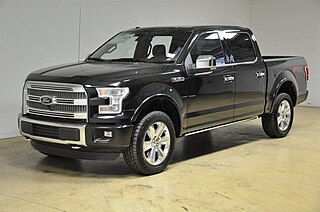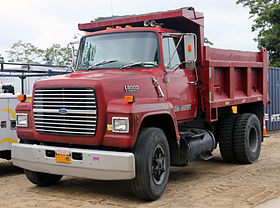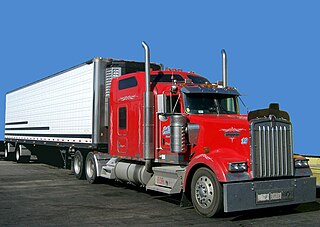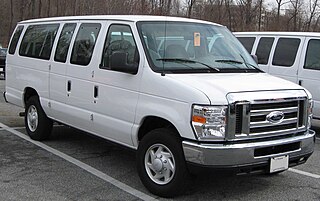
The Ford E series is a range of full-size vans produced by the American automaker Ford since 1960. Introduced for the 1961 model year as the replacement for the Ford F-series panel van, four generations of the model line have been produced. In addition to cargo van and passenger van body styles, the Ford E series has been produced as a cutaway van chassis and stripped chassis.

The Ford Excursion is a heavy duty, extended-length sport utility vehicle that was produced by Ford from 1999 to 2005, launched for 2000 in the North American market. The longest and heaviest SUV ever to enter mass production, the Excursion was based upon the Ford F-250 Super Duty pickup truck. A 3⁄4-ton (0.68 t) chassis vehicle, the Ford Excursion was designed as a competitor for the 2500-series Chevrolet Suburban and GMC Yukon XL.

The Ford F-Series Super Duty is a series of trucks manufactured by Ford Motor Company. Introduced in 1998 for the 1999 model year, the F-Series Super Duty trucks marked the addition of a heavy-duty pickup to the Ford F-Series range with the new versions of the F-250 and F-350 pickups, while the previous 1987–1997 F-Super Duty chassis cabs were replaced by the F-450 and F-550 Super Duty.
The Chevrolet and GMC B series is a series of cowled chassis that were produced by General Motors, primarily fitted with school bus bodies throughout its production. Based on the medium-duty trucks produced by the Chevrolet and GMC divisions of General Motors, the B series was produced in three separate generations; GMC initially produced its own version separate from Chevrolet. Introduced in 1966, the B series was redesigned in 1984 and 1992 as a 1993 model.

The Chevrolet Kodiak and GMC TopKick are a range of medium duty trucks that were produced by the Chevrolet and GMC divisions of General Motors from 1980 to 2009. Introduced as a variant of the medium-duty C/K truck line, three generations were produced. Slotted between the C/K trucks and the GMC Brigadier Class 8 conventional, the Kodiak/TopKick were developed as a basis for vocationally-oriented trucks, including cargo haulers, dump trucks, and similar vehicles; on later generations, both cutaway and cowled-chassis variants were produced for bus use.

The medium-duty Ford F-Series is a range of commercial trucks manufactured by Ford since 1948. Derived from the smaller F-Series pickup trucks, the medium-duty range is currently in its eighth generation. Initially slotted between the F-Series pickup trucks and the "Big Job" conventionals, later generations were slotted below the L-Series "Louisville" trucks; during its production, the medium-duty F-Series has been used for an extensive number of applications, competing against the medium-duty Chevrolet/GMC C/K, International S-series, and Freightliner Business Class.
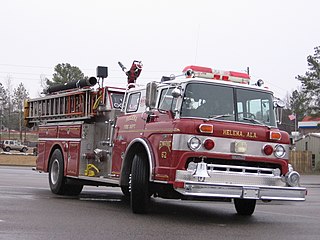
The Ford C series is a range of trucks that was assembled by Ford between 1957 and 1990. The first cab-over engine (COE) truck produced with a tilting cab by Ford, the C-series replaced the C-series COE variant of the F-series, produced since 1948. Produced as both a straight/rigid truck and a tractor, a wide range of versions of C-series was produced, ranging from Class 5 to Class 8 GVWR ratings. The C-series was also used as a basis for fire apparatus production.
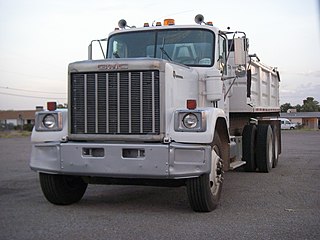
The GMC General are heavy-duty trucks that were assembled by the GMC Truck and Coach Division of General Motors. The largest conventional-cab truck ever produced by GM, the product line was introduced for 1977, replacing the C/M 90/9500 trucks.

The Chevrolet Bruin and GMC Brigadier are heavy-duty trucks that were assembled by the GMC Truck and Coach Division of General Motors. The second generation of the H/J-series heavy-duty conventionals, the Bruin/Brigadier were produced from 1978 to 1988. A short-hood conventional similar to the Ford L-Series and Mack Model R, the Bruin/Brigadier was configured as both a straight truck and a semi-tractor. As a Class 7-8 truck, the product line saw use with short-haul, vocational, and severe-service users.
The International DuraStar, is a product line of medium-duty trucks produced by Navistar International from 2001 to 2018. Introduced as the successor to the International 4000 series of 1989–2001, the 4000 series was renamed the DuraStar in 2008. Developed as a Class 6-7 product range, the 4000/DuraStar was slotted below the 8000/TranStar regional-haul semitractor, with the Class 5 International TerraStar (2010–2015) serving as the smallest International conventional-cab product range.

The International S series is a range of trucks that was manufactured by International Harvester from 1977 to 2001. Introduced to consolidate the medium-duty IHC Loadstar and heavy-duty IHC Fleetstar into a single product range, the S series was slotted below the Transtar and Paystar Class 8 conventionals.
The bus chassis variant of the International S series is a cowled bus chassis that was produced by International Harvester from 1979 to 2004. Produced primarily for school bus applications, the chassis was also produced for other applications, including commercial-use buses and cutaway-cab buses. In addition, the cowled chassis formed the basis for front-engine and rear-engine stripped chassis produced for bus applications.
Daimler Trucks North America LLC, formerly Freightliner Corporation, is an automotive industry manufacturer of commercial vehicles headquartered in Portland, Oregon, and is a wholly owned subsidiary of the German Daimler AG.

The Ford B-series is a bus chassis that was manufactured by the Ford Motor Company. Produced across six generations from 1948 to 1998, the B-series was a variant of the medium-duty Ford F-Series. As a cowled-chassis design, the B-series was a bare chassis aft of the firewall, intended for bodywork from a second-stage manufacturer. While primarily used for school bus applications in the United States and Canada, the chassis was exported worldwide to manufacturers to construct bus bodies for various uses.
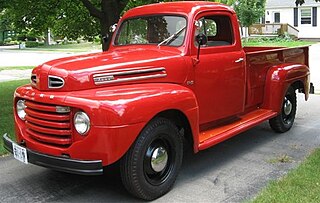
The first-generation of the Ford F-Series is a series of trucks that was produced by Ford in North America from 1948 to 1952. While trailing the Chevrolet Advance Design trucks by a year, the introduction of the F-Series marked the divergence of Ford car and truck design, developing a chassis intended specifically for truck use.
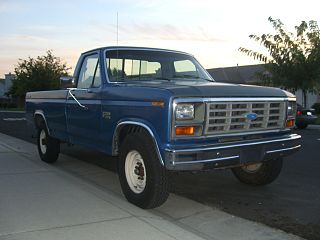
The seventh generation of the Ford F-Series is a line of pickup trucks and medium-duty commercial trucks that was produced by Ford from 1979 to 1986. For the first time since 1965, the pickup trucks were based upon a completely new chassis and body. Distinguished by its squarer look, sharper lines and flatter panels, the trucks were designed with improved fuel efficiency in mind; to this end, Ford added its new AOD automatic overdrive (four-speed) transmission as an option on light-duty models. The 4-speed manual and 3-speed C6 automatic transmission were retained from previous years. To increase longevity, Ford increased the use of galvanized body panels to fight corrosion. Light Pickups were available in six configurations: Regular Cab, SuperCab, or Crew Cab, in either 6ft or 8ft bed lengths. They are typically considered to be the last of the "classic" Ford trucks, due to features such as sealed beam headlights that would become obsolete in the next body style.

The ninth generation Ford F-Series is a line of full-size and medium-duty commercial trucks that were produced by Ford from 1991 to 1997. While still based on the basic design dating from late 1979, the 1992 F-Series brought a number of minor changes to the exterior and interior. This is the last generation of the F-Series that was produced as a complete range of trucks from a half-ton pickup (F-150) to a medium-duty Class 6 truck. As this generation was replaced during the 1997–1998 model years, the larger models of the F-Series were split from the F-150; these became the Ford Super Duty trucks, related to the latter with a few powertrain components.

